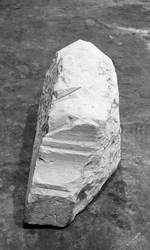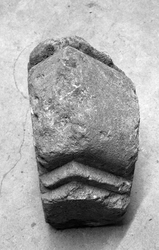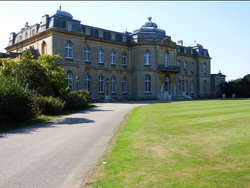
The Corpus of ROMANESQUE SCULPTURE in Britain & Ireland

English Heritage Stone Store
English Heritage Stone Store
Numerous carved stones were excavated at Battle Abbey by Sir Harold
Brakspear in the 1930s and John Hare in 1978–80, including 20 fragments
of Romanesque sculpture. These fragments are now distributed between the
English Heritage stone stores at Fort Brockhurst and Dover Castle, and a
display in Battle Abbey gatehouse, but only 12 could be located for the Corpus,
including one chevron
voussoir
at Dover Castle. Inventory number: 725 (?) in white paint, partly erased.See also: Battle Abbey, Fort Brockhurst, Fort Cumberland.
English Heritage Stone Store
Numerous carved stones were excavated at Battle Abbey by Sir Harold Brakspear in the 1930s and John Hare in 1978-80, including 20 fragments of Romanesque sculpture. These fragments are now distributed between the English Heritage stone stores at Fort Brockhurst, Fort Cumberland, Dover Castle, and a display in Battle Abbey gatehouse, but only 12 could be located for the Corpus, including one chevron voussoir at Fort Brockhurst. It is possible that other carved fragments are stored at Fort Brockhurst, where the quantity and weight of the material made it impossible to examine everything.
See also: Battle Abbey (Sussex), Dover Castle (Kent), Fort Cumberland (Hants).
English Heritage Stone Store
The English Heritage collections store at Wrest Park contains material from sites in the east of England. For ease of accessing the material by site, we have decided to treat each source site within the store as a separate site, despite the fact that all the stones are housed in the same buildings at Wrest Park, hence this report only includes the stones from Bury St Edmunds Abbey.
Wrest Park is an English Heritage property; a 19thc house built to look like a French chateau, set in formal 17-18thc gardens given a touch of wildness by Capability Brown in the later 18thc. Wrest Park was bought by the Minstry of Works in 1946, who leased it to the National Institute of Agricultural Engineering (later the Silsoe Research Institute). It was taken over by English Heritage in 2006, and in 2013 a large warehouse to the E of the house, formerly used to store agricultural equipment, was converted into the EH Collections Store. It is one of several EH stores in England, and contains more than 160,000 objects from sites in the East and West Midlands, East of England and London.
The material is stored on rows of tall shelves; each row identified by a letter and each bay within the row by a number. The Bury material that has been shelved is in Row Z, bays 3 and 4 (Z-03, Z-04).
The architectural stonework from Bury St Edmunds held at the Wrest Park store is estimated to consist of approximately 1,000 pieces, and before it came to Wrest Park it was held by the Suffolk Museums Service at their West Stow site. The Bury stones at Wrest Park are generally marked with numbers with a 7810 prefix, which is taken to indicate that they came from the Ministry of Works excavations at the east end of the abbey church in 1957-64. Unfortunately this excavation was never properly reported; all we have is a short summary report by Roy Gilyard Beer published five years after the end of the dig. It is clear from the state of the material that it was never assessed or sorted, and the numbers written on the stones tell us nothing about where they were found during the excavation. Many of the stones have little or no real evidential value. Most bear some evidence of tooling or carved motifs, but many are mere fragments; too small for their purpose to be identified. A grimacing head sculpture on display at the Moyses Hall museum also bears the 7810 prefix number, and can be assigned to the Ministry of Works excavation.
When the Wrest Park stones were examined by the authors they had not all been shelved. There were 90 crates stacked on pallets containing mostly small stones, bagged by volunteers but not assessed, and approximately 50 plastic boxes containing larger stones. These were all in the main store. In the Orangery basement were larger crates holding big stones. Not all of the material was Romanesque, and indeed a high proportion could not be confidently assigned to any date. The stones chosen for reporting here had to fulfil the criteria of being both Romanesque and of an identifiable type. The authors are grateful to Dickon Whitewood of English Heritage for arranging access to the store, and for his invaluable assistance in the recording process.


